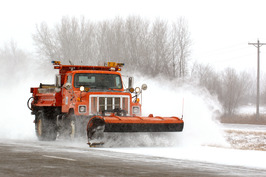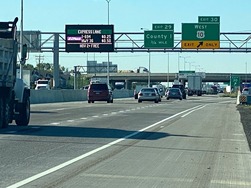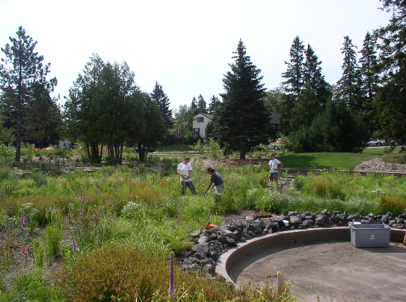|
Transportation Research Update
 Using Advanced Data Analytics to Reduce Snowplow Fuel Consumption

MAINTENANCE OPERATIONS - MnDOT snowplows, while keeping winter roads safe, consume over 1 million gallons of fuel annually. In addition to the taxpayer cost, these trucks are a substantial source of greenhouse gas emissions. To increase efficiency and help meet its sustainability goals, MnDOT continually seeks ways to decrease fuel consumption. New advanced analyses of existing data can inform these efforts and illustrate the potential of using this data for enhancing winter maintenance management.
A database created from onboard computers installed in snowplows was mined for specific data on snowplow fuel consumption and factors that may impact it. Analyzing idling events of over 900 vehicles from the 2018 to 2022 winter seasons found 52,000 hours of idling consumed 4.2% of the total fuel used. A process combining snowplow data with historical weather data illustrated the impact of snowfall levels on snowplow fuel efficiency. On days with a snowfall of 4 or more inches, fuel use increased 29% on average compared to dry days. These results can inform MnDOT’s placement of snow fences and efforts to reduce truck idling.
|

EQUITY - Managed lanes offer transportation agencies a strategy for reducing congestion and improving travel times along urban highways. These designated corridors, known as E-ZPass lanes in Minnesota, are free to transit riders and carpoolers during high-traffic times and available to solo drivers for a fee. There’s a common perception that higher income communities and individuals are the primary beneficiaries of E-ZPass lanes. New research shows that E-ZPass lane users are, in fact, relatively diverse in terms of race and income. Transportation agencies also have new tools to maximize equity considerations in highway planning for managed lanes.
In this study, researchers first compared the demographics of E-ZPass lane users to the overall demographics in the general areas where the managed lanes are located. They found that because 80% of E-ZPass lane users were carpoolers or transit riders, E-ZPass lane users are slightly more diverse and have similar income levels to overall travel shed users. Researchers identified nine metrics to evaluate potential equity impacts in transportation planning and environmental studies. Agencies can use these measures not only in planning for managed lanes but planning for any highway project. Other study recommendations included methods for further enhancing managed lane equity and improving equity evaluation within transportation planning processes.
|
Climate Change Adaptation of Urban Stormwater Infrastructure

Stormwater runoff from intense rainstorms is controlled by MnDOT’s network of pipes, retention ponds and swales to protect communities, roads, bridges and natural resources from flooding. Severe storms are projected to increase, and predicted development will increase impervious land area and potentially runoff. MnDOT wanted to ensure runoff is adequately managed. New research updates rainfall projections and analyzes cost-effective stormwater management strategies for the future.
Investigators modeled how effectively a variety of methods to control runoff would prevent flooding in three watersheds during severe storms. The modeled storms involved intense rainfall over a few hours and are not expected to happen very often (once every 10 or more years). Stormwater control strategies examined included infiltration basins, retention ponds and stormwater pipes. Calculated costs of constructing and maintaining the strategies over a 20-year life cycle identified new stormwater ponds as generally the most cost-effective strategy. However, infiltration basins with deep-rooted vegetation would work well to control stormwater from more common storms with rainfall occurring more uniformly over a day’s time. MnDOT will continue to assess the adequacy of its stormwater infrastructure as storm patterns change and development occurs around the state.
|
Influence of Autonomous Vehicles on Minnesota Roads

TRAFFIC AND SAFETY - Autonomous vehicles (AVs) are not quite road-ready but most new vehicles are partially autonomous, using features like adaptive cruise control and cameras for detecting a lane by its markings. The Local Road Research Board and MnDOT want to understand how these vehicles will impact traffic, safety and road maintenance. What happens, for example, when snow is covering lane markings? New research answered this question and others, highlighting issues agencies can continue exploring.
Researchers conducted a series of tests on a new vehicle retrofitted with sensors, cameras and software to perceive and interpret the surrounding environment. The car could identify the distance to a vehicle ahead, the relative speed of the preceding vehicle and lane markings. This information enabled autonomous steering and speed and braking control. The vehicle demonstrated mixed results when driving in different levels of traffic and varying levels of snow-covered highways and local roads. Automated driving produced decreased acceleration and deceleration, which would result in smoother traffic flow compared to manual driving. The car was not able to navigate through work zones or in snowy conditions unless the lane markings were clearly visible. Technology improvements and agencies’ investigations into how AVs will influence the operation and maintenance of Minnesota’s roads will continue.
|
Assessing Stormwater Ponds for Phosphorus Retention

ENVIRONMENT - Local governments manage stormwater in wetlands and both natural and constructed stormwater ponds. The ponds reduce flood risk in communities and retain pollutants from fertilizer, animal waste and other products that are found in stormwater runoff. One of these pollutants—phosphorus—sinks to the bottom of the pond and remains in the pond sediment. As ponds age, however, the vegetation, water depth and other pond characteristics may change. As a result, phosphorus may be released from the sediment and potentially enter streams and lakes. A new tool can help local governments better manage these ponds to retain phosphorus.
Leveraging previous research, investigators sampled and monitored several ponds over two years. In addition to sediment testing in the laboratory, they analyzed both the collected data and data from the past 15 years from approximately 230 ponds in the Twin Cities metro area. The identification of pond characteristics that correlated with high phosphorus levels led to the creation of a pond assessment tool. Local managers can use the tool to understand which ponds may be at highest risk of releasing phosphorus and where managers should focus remediation efforts or use other management practices to ensure the ponds are performing as designed.
|
|
|
|
MnDOT invites and encourages participation by all people in their programs, services and activities.
If you need an ASL, a foreign language interpreter, or documents in an alternative format (such as braille, large print or in a different language) at no cost, please email your request to Janet Miller at ADArequest.dot@state.mn.us or call 651-366-4720. Relay service: 711.
If you need any other reasonable accommodation to participate (such as seating modification or auxiliary aids), please email your request to Accessibility.DOT@state.mn.us or call 1-833-400-8432. Relay service: 711.
|
|
|
|